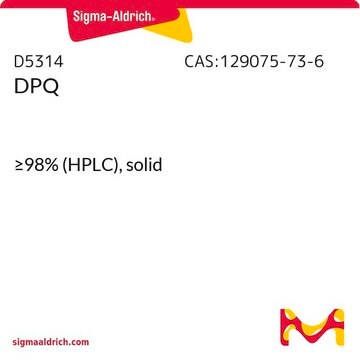H3537
HEPES solution
99.5%, liquid, BioPerformance Certified, 1 M, suitable for cell culture, 0.2 μm filtered
Synonim(y):
N-(2-Hydroxyethyl)piperazine-N′-(2-ethanesulfonic acid)
About This Item
Polecane produkty
product name
HEPES solution, BioPerformance Certified, 1 M, suitable for cell culture, 0.2 μm filtered
klasa czystości
BioPerformance Certified
Poziom jakości
sterylność
0.2 μm filtered
Postać
liquid
stężenie
1 M
metody
cell culture | mammalian: suitable
zanieczyszczenia
Bioburden, tested
DNase, RNase, Protease, Nickase, free
endotoxin, tested
pH
5.0-6.0
przydatny zakres pH
6.8-8.2
ślady kationów
Fe: <5 ppm
heavy metals (as Pb): <5 ppm
przydatność
suitable for molecular biology
Zastosowanie
diagnostic assay manufacturing
ciąg SMILES
OCCN1CCN(CCS(=O)(O)=O)CC1
InChI
1S/C8H18N2O4S/c11-7-5-9-1-3-10(4-2-9)6-8-15(12,13)14/h11H,1-8H2,(H,12,13,14)
Klucz InChI
JKMHFZQWWAIEOD-UHFFFAOYSA-N
Szukasz podobnych produktów? Odwiedź Przewodnik dotyczący porównywania produktów
Powiązane kategorie
Opis ogólny
Zastosowanie
- To supplement Dulbecco′smodified Eagle′smedium for maintenance of cell line and RPMI medium to wash rat islets
- To recover purified ribonucleotide
- As a component of HEPES/KOH buffer and adenylation buffer for small RNA isolation and sequencing
- As a component in buffers used for nuclear extract preparation and also to supplement RPMI-1640 medium for maintenance of islets
Kod klasy składowania
10 - Combustible liquids
Klasa zagrożenia wodnego (WGK)
WGK 1
Temperatura zapłonu (°F)
Not applicable
Temperatura zapłonu (°C)
Not applicable
Certyfikaty analizy (CoA)
Poszukaj Certyfikaty analizy (CoA), wpisując numer partii/serii produktów. Numery serii i partii można znaleźć na etykiecie produktu po słowach „seria” lub „partia”.
Masz już ten produkt?
Dokumenty związane z niedawno zakupionymi produktami zostały zamieszczone w Bibliotece dokumentów.
Klienci oglądali również te produkty
Produkty
Human pancreatic cancer organoid biobank (PDAC organoids) with various KRAS mutations to aide in 3D cell culture and cancer research applications.
Nasz zespół naukowców ma doświadczenie we wszystkich obszarach badań, w tym w naukach przyrodniczych, materiałoznawstwie, syntezie chemicznej, chromatografii, analityce i wielu innych dziedzinach.
Skontaktuj się z zespołem ds. pomocy technicznej









